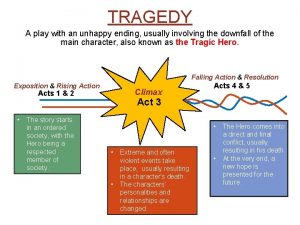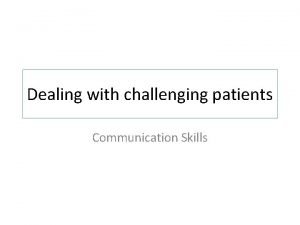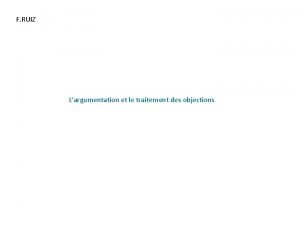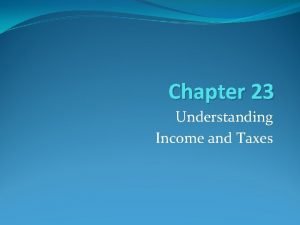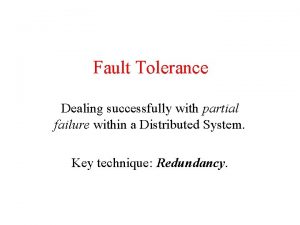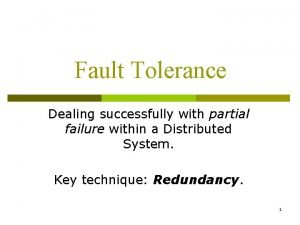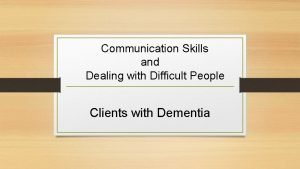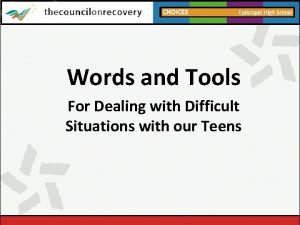Chapter 13 Understanding and Dealing Successfully With Difficult





















































- Slides: 53

Chapter 13 Understanding and Dealing Successfully With Difficult Behavior Joseph T. Catalano Copyright © 2015. F. A. Davis Company

People With Difficult Behavior § All behavior is a type of communication. § In dealing with the group labeled “difficult people, ” the primary goal is to change our response to the behaviors. § The secondary goal is to attempt to change the behaviors they are displaying. Copyright © 2015. F. A. Davis Company

People With Difficult Behavior (cont’d) § All children are genetically stamped in the womb with innate emotions. § These emotions include § § Anger Jealously Selfishness Self-centeredness § These emotions help them survive in a world that they real don’t understand is very frightening to them. Copyright © 2015. F. A. Davis Company

People With Difficult Behavior (cont’d) § Primary goals of parents § Teach their children adult coping skills. § Show children how to deal with problems in an adult way. § Help children outgrow the immature and childish coping mechanisms of manipulation and exploitation of others. Copyright © 2015. F. A. Davis Company

People With Difficult Behavior (cont’d) § Some people go through their whole lives using child-like coping mechanisms and behaviors to deal with the adult world. § They don’t work very well with others. § They get labeled as difficult people. § They never learned how to use adult coping mechanisms. Copyright © 2015. F. A. Davis Company

People With Difficult Behavior (cont’d) § People who display difficult behaviors are everywhere. § They are found § At home § At work § In the health-care setting § Communicating with them requires a special set of communication skills. Copyright © 2015. F. A. Davis Company

People With Difficult Behavior (cont’d) § Signs of a person with difficult behavior § They are hard to communicate with. § Their behavior makes it very difficult to work with them to achieve a goal or finish a task. § They have a “prickly” personality because if they are touched verbally, they sting back with sharp vocal barbs and quills. § They often use communication blockers. Copyright © 2015. F. A. Davis Company

People With Difficult Behavior (cont’d) § There are two primary groups of difficult people in the health-care setting. § Coworkers (can make life difficult, but no ethical obligation to interact with them) § Clients (must make every effort to establish communication with them and provide the highest level care possible) Copyright © 2015. F. A. Davis Company

People With Difficult Behavior (cont’d) § The behavior displayed by a difficult person is really a symptom of a deeper underlying problem. § Identifying the cause of the problem and the outcomes the client is attempting to achieve permits the nurse to treat the disease rather than just the symptoms. § The problem is never cured by merely ignoring it or dealing only with the symptoms. Copyright © 2015. F. A. Davis Company

Coworkers With Difficult Behavior § There are several types of difficult coworker personalities. § The two most common types are § The persecutor § The sneak § They require different strategies for communication and dealing with their behaviors. Copyright © 2015. F. A. Davis Company

Coworkers With Difficult Behavior (cont’d) § The persecutor § Also called dictators and bullies § Generally display an attitude of being superior to others and being in control § They attempt to § Humiliate § Intimidate § Threaten § Demean other individuals or groups Copyright © 2015. F. A. Davis Company

Coworkers With Difficult Behavior (cont’d) § The persecutor (cont’d) § Primary goals include overcoming their own § Lack of confidence § Low self-esteem § This behavior is habitual. § It becomes the person’s primary mode of communication and interaction. Copyright © 2015. F. A. Davis Company

Coworkers With Difficult Behavior (cont’d) § Characteristics of persecutors § Inconsistency in behavior and demands § Unable to accept ideas that are different from theirs § Use loud speech and threats to keep other persons from expressing new ideas § Try to provoke the other person into an angry defensive outburst, then use the “What, me? ” response § Primary messages conveyed by their behavior include § “If you don’t do what I want, I’ll make your life miserable!” § “If you do what I want, I’ll stop harassing you, maybe!” § “If you give into my wants, you can become one of my minions and help me demean others!” Copyright © 2015. F. A. Davis Company

Coworkers With Difficult Behavior (cont’d) § Taming the persecutor § Good communication skills become coping skills in interacting with persecutors. § Everyone develops coping skills as they mature. § They use them when confronted with § § § Difficult or complex situations Crisis situations Anxiety Difficult issues of communication Everyday life situations § Use your basic set of coping skills as the foundation for adding to or building new coping skills to deal with persecutors. § This requires a willingness to change and a lot of practice. Copyright © 2015. F. A. Davis Company

Coworkers With Difficult Behavior (cont’d) § Self-perception and knowledge § These are significant elements in dealing with the persecutor. § You need to understand your own perceptions and how they affects actions and thoughts when confronting a persecutor. § Dealing with the persecutor requires a high level of § § Personal confidence and inner strength Self-awareness Emotional self-control Self-knowledge Copyright © 2015. F. A. Davis Company

Coworkers With Difficult Behavior (cont’d) § Actions to use in taming the persecutor § Set the stage for communication. § Listen to what is really being communicated: verbal and nonverbal. § Use assertive but not aggressive communication. § Use a line of discussion that will get their attention. § Remember, persecutors are acting the way they do because of some lack in their lives. Copyright © 2015. F. A. Davis Company

Coworkers With Difficult Behavior (cont’d) § Actions to use in taming the persecutor (cont’d) § § § Avoid doing nothing. Avoid personal attacks. Avoid judging what a person is doing. Ask clarifying questions. Ignore trivia. Copyright © 2015. F. A. Davis Company

Coworkers With Difficult Behavior (cont’d) § The Sneak § Also called double-crossers or back stabbers § They fulfill their self-esteem needs and achieve their goals to be in control by using devious, underhanded and often malicious attacks when you aren’t looking. § They obtain their rewards by watching the discomfort and confusion of their target. § They elicit the help of others who are afraid of them. § They gang up on a person as a group behind his or her back through gossip. Copyright © 2015. F. A. Davis Company

Coworkers With Difficult Behavior (cont’d) § Characteristics of sneaks § They have very few true friends. § Subconsciously they feel they lack the talent, intelligence, or skills to be successful. § Use covert manipulative behavior to gain promotions and advance their position. § Attempt to gain attention from a superior. § Feel a strong sense of jealousy when the superior gives the attention or promotion they want to another person. § They are very sensitive to criticism. § Feel slighted angry at people who may have unintentionally said something that hurt their feelings. Copyright © 2015. F. A. Davis Company

Coworkers With Difficult Behavior (cont’d) § Manipulative methods used by the sneak to achieve his or her goals § § § § Personal digs Rumors and mixed rumors Accusations False allegations Finger pointing Innuendoes Appear very friendly when they are communicating face to face Copyright © 2015. F. A. Davis Company

Coworkers With Difficult Behavior (cont’d) § Manipulative methods used by the sneak to achieve his or her goals (cont’d) Exploit others’ weaknesses to lower their esteem. Attempt to discredit others. Make others appear inferior. Avoid confrontation at all costs. Try to keep the workplace in a state of uncertainty, tension, and disorder. § Use divide and conquer technique. § § § Copyright © 2015. F. A. Davis Company

Coworkers With Difficult Behavior (cont’d) § Unveiling the sneak § As with the persecutor, perception and self-knowledge are significant elements in dealing with the sneak’s behavior. § You need to understand how and why you react the way you do when suffering the aftermath of a sneak’s attack. § Your reaction is a behavior that you can and need to change. § It’s unlikely the sneak will change his or her behaviors to any great degree. § Understanding your own motives, preferences, beliefs, and biases can help in softening the devastation you feel after the attack. Copyright © 2015. F. A. Davis Company

Coworkers With Difficult Behavior (cont’d) § Methods to use to unveil the sneak § Make the decision to talk to them about their behavior. § Let them know that you know. § Let the group know that you heard what the sneak said. § Do not show your hostility toward the sneak in front of a group (makes them the martyr). Copyright © 2015. F. A. Davis Company

Coworkers With Difficult Behavior (cont’d) § Methods to use to unveil the sneak (cont’d) § Stay on point when you finally speak with them– they will try to change the subject. § Try to treat them with empathy and understanding. § Listen carefully to their response. § Plan for future interactions. § Forewarned is fore-armed–they will seek revenge. Copyright © 2015. F. A. Davis Company

Clients With Difficult Behaviors (cont’d) § The nurse is legally and ethically bound to provide the best care possible for all clients, even those who are displaying behavior that makes communication or care difficult. § Although some clients may § Be persecutors or sneaks § Have undiagnosed personality disorders § The majority of clients displaying difficult behaviors that the nurse will encounter in practice, are acting that way as a response to their illnesses or injuries. Copyright © 2015. F. A. Davis Company

Clients With Difficult Behaviors (cont’d) § We usually think of grief as being associated with a loss, such as the death of a loved one. § Clients who are severely ill, severely injured, or who have had major surgeries, amputations, or loss of internal body parts, or who may be facing death, also often go through the stages of grief. § § § Denial Anger Guilt Depression Resolution Copyright © 2015. F. A. Davis Company

Clients With Difficult Behaviors (cont’d) § Two primary goals in caring for clients who are working through the grief stages § To provide the best care possible so that they will survive and recover from their illness (meet their physiological and safety needs). § To help these clients work their way through the stages of grief until they reach resolution. § The ideal is to be able to achieve both goals simultaneously, however, that is not always possible. § Goal 1 will always have the highest priority. Copyright © 2015. F. A. Davis Company

Clients With Difficult Behaviors (cont’d) § Maslow believed that if the lower level needs are not met, the person is unable to move to the higher level needs fulfillment. § Severely ill clients, in some ways, are starting at the lower level needs. § Key responsibility of nurses § To aid clients in maintaining their physiological and safety needs so that they can move back up to their prior levels of adjustment. Copyright © 2015. F. A. Davis Company

Clients With Difficult Behaviors (cont’d) § Establishing trust is key to a successful nurseclient relationship. § It is the foundation upon which all nursing care is built. § It is particularly important when dealing with difficult behavior. Copyright © 2015. F. A. Davis Company

Clients With Difficult Behaviors (cont’d) § Key elements in establishing trust § § Respect Consistency Confidentiality Loyalty Copyright © 2015. F. A. Davis Company

Clients With Difficult Behaviors (cont’d) § One way to manage difficult client behaviors is to organize care around the stages of grief and prioritize each one by the levels of Maslow’s Hierarchy of Needs. § The physiological and safety needs must always be met first in each of the stages of grief. Copyright © 2015. F. A. Davis Company

Clients With Difficult Behaviors (cont’d) § Denial § Also sometimes called the “I’m Fine Syndrome. ” § It is used as a coping mechanism to give people time to adjust to sudden traumatic situations. § It is an unconscious process that protects the individual from feeling vulnerable or losing control. Copyright © 2015. F. A. Davis Company

Clients With Difficult Behaviors (cont’d) § Anger § Expressions of anger can range from a mild sense of frustration to declarations of injustice or raging destructive behaviors that must be stopped immediately. § As clients move away from the denial stage and the protective veil of refusal falls away, they are often not prepared for the flood of intense emotions they are experiencing. § They have suddenly become vulnerable and recognize that they have lost much of their control over their lives and their destiny. Copyright © 2015. F. A. Davis Company

Clients With Difficult Behaviors (cont’d) § Bargaining § An unconscious coping mechanism that seeks to fulfill the goals of avoiding the bad things that the client anticipates will soon happen. § This helps them regain some degree of control over their lives. § It is also an expression of hope, often unrealistic, on the part of the client, frequently based on irrational beliefs or incomplete information. Copyright © 2015. F. A. Davis Company

Clients With Difficult Behaviors (cont’d) § Depression: client experiences feelings of emptiness and sadness. § Starts when the client comes to the full realization of § § The severity of the illness The discomfort and pain The length of the treatments How the illness is going to affect their future § Grief stage depression is not a mental illness or clinical condition. § It’s a natural response to the loss of independence, control, self-esteem, and, to some degree, hope that the client is experiencing from their illness or injury. Copyright © 2015. F. A. Davis Company

Clients With Difficult Behaviors (cont’d) § Acceptance § A mental state where clients are willing to accept and to move on with their changed lives. § Acceptance does not mean that the client is cured or that they’ve forgotten about what happened to them. § Being in the acceptance stage means that they are willing to § Deal with the future § Accommodate the changes brought on by the illness § Acceptance is not a period of happiness and joy. § It is a state of calm and peace that comes from coming to terms with the reality that the client is facing. § Often clients will feel a sense of strength that they now can make sense of how their lives will be. Copyright © 2015. F. A. Davis Company

Non-Grief Stage Difficult Behaviors § Inappropriate sexual behavior (ISB) § Coworker behavior: it is really a form of bullying. § Individuals who use it in the workplace are attempting to coerce or influence their coworkers by using ISB. § Although they use sexual content, usually the underlying issues involve elements of controlling others or humiliating others because of feelings of powerlessness, inadequacy, or low self-esteem. § The person using sexual harassment has many of the same personality traits as the persecutor. Copyright © 2015. F. A. Davis Company

Non-Grief Stage Difficult Behaviors (cont’d) § Inappropriate sexual behavior (ISB) (cont’d) § Workers are legally protected from sexual harassment. § All institutions are required to have written polices about ISB in their employee manuals. § Legally, sexual harassment is defined as any unwelcomed sexual advances, requests for favors, or any other verbal or physical behavior of a sexual nature that creates a hostile working environment. Copyright © 2015. F. A. Davis Company

Non-Grief Stage Difficult Behaviors (cont’d) § Client ISB § ISB from clients creates a dilemma for nurses. § Nurses must walk a fine line between protecting themselves and providing quality care. § However, what most nurses don’t know, is that federal and some state laws protect them from sexual harassment by clients. § These laws should be reflected, or at least referenced, in the employee manual. § Nursing students receive little education on dealing with clients who sexually harass nurses. Copyright © 2015. F. A. Davis Company

Non-Grief Stage Difficult Behaviors (cont’d) § ISB from clients is § § § Disturbing Increases job-related stress for the nurse Makes the nurse feel humiliated and objectified Decreases the quality of care Can destroy the nurse-client trust § ISB in clients may be associated with § § § A stage of grief, particularly anger Mental illnesses Dementia Brain damage or surgery Medications that have neurological effects § These conditions create a unique situation for nurses because these clients may not respond to the usual actions used in dealing with ISB. Copyright © 2015. F. A. Davis Company

Non-Grief Stage Difficult Behaviors (cont’d) § The American Nurses Association (ANA) approach to ISB § The ANA has developed a four-step approach to deal with clients who display ISB. § Step 1. Confrontation of the offender § Step 2. Notify the supervisor of the harassment § Step 3. Careful documentation § Step 4. Involve others Copyright © 2015. F. A. Davis Company

Non-Grief Stage Difficult Behaviors (cont’d) § Complaining and whining behaviors § Types of complaining behavior § Duck and cover behavior § Complaints are intertwined with real problems. § It is difficult to separate the two. § They try to place the responsibility for both the problem and its solution on another person. Copyright © 2015. F. A. Davis Company

Non-Grief Stage Difficult Behaviors (cont’d) § Complaining and whining behaviors (cont’d) § Bulldozer behavior § They want immediate action in accomplishing their goals. § They use aggressive complaining to manipulate others into working with them. Copyright © 2015. F. A. Davis Company

Non-Grief Stage Difficult Behaviors (cont’d) § Complaining and whining behaviors (cont’d) § Wet blanket behavior § Used to gain control and manipulate a situation. § Their negative comments and complaints dampen everyone else’s attitudes and ideas. § They rarely have any good ideas of their own. § They prefer to tear down others’ hopes and ideas. Copyright © 2015. F. A. Davis Company

Non-Grief Stage Difficult Behaviors (cont’d) § Complaining and whining behaviors (cont’d) § Beyond help behavior § They appear to be seeking help and support with a problem they are facing. § However, they immediately reject the help offered without even considering it. § They believe the solution being offered is inappropriate or useless. § They believe that their problem is so severe or unique that there is nothing anyone could ever do to fix it. § Their goal is to gain attention and sympathy from other people. § They really do not want to solve the problem, or, if it does get solved, they’ll find another problem. Copyright © 2015. F. A. Davis Company

Non-Grief Stage Difficult Behaviors (cont’d) § Complaining and whining behaviors (cont’d) § Gossiping behavior § Use complaining to make themselves § Look better § Cover up their feelings of inadequacy and low self-esteem § Gain recognition or attention § Tactics include § § § Interrupting others Bragging about their accomplishments Throwing up road blocks to progress Making unrealistic promises they can’t keep Using others as scapegoats Taking the credit for another nurse’s work Copyright © 2015. F. A. Davis Company

Non-Grief Stage Difficult Behaviors (cont’d) § Complaining and whining behaviors (cont’d) § Needy behavior § They complain and then emotionally and physically withdraw. § They are chronic complainers seeking to gain the sympathy of others. § They want to develop some type of connection, even if it is dysfunctional. § They will set up social or work situations where they intentionally fail so that they can become the victim. § Being a victim is a role for which they were born and they revel in it. Copyright © 2015. F. A. Davis Company

Non-Grief Stage Difficult Behaviors (cont’d) § Complaining and whining behaviors (cont’d) § Toxic behavior § These are chronic complainers who are so unhappy with themselves § § § and their lives that they use their behavior to purposely manipulate or poison the environment so everyone else will be as unhappy as them. This can be particularly devastating if the person using this toxic complaining behavior is the boss. They sometimes have secondary goals for their behaviors, such as seeking a promotion or recognition rewards. They will attempt to falsely inflate others’ perception of their skills and work hard to advance their own agenda. People who use this type of toxic behavior often will retaliate and seek revenge if they are contradicted or challenged. Toxic complaining can deeply torment fellow workers and devastate their emotional state. Copyright © 2015. F. A. Davis Company

Non-Grief Stage Difficult Behaviors (cont’d) § Approaches to complaining behavior § Help them recognize that their behaviors are inappropriate and that expressing their needs by complaining is harmful to themselves and the work environment. § Help them understand why they are complaining. § People who complain often have little capacity for empathy. § Try to get them to see from another person’s point of view. § With even a little empathy, they will § § Be able to see other persons more positively Begin to think differently Have different expectations Find better ways of handling things in their lives other than complaining Copyright © 2015. F. A. Davis Company

Non-Grief Stage Difficult Behaviors (cont’d) § The empathy approach to complaining § Active listening can also work with the complainer if combined with a response that acknowledges their problems. § Break the vicious cycle approach § Similar to the empathy approach. § May not completely stop the complainer from complaining. § Requires being patient with the person and responding realistically to their complaints. Copyright © 2015. F. A. Davis Company

Non-Grief Stage Difficult Behaviors (cont’d) § Adjusting the attitude approach § Complainers often do not realize how good they actually have it and how much they can be thankful for. § This approach is difficult because it requires the person to shift their perception from one they have been hanging on to for many years. § Helping adjust their perception of themselves and what they have and can do will allow them to become more positive and speak of the good things in their lives. § They need even a small degree of self-awareness for this to be successful. Copyright © 2015. F. A. Davis Company

Non-Grief Stage Difficult Behaviors (cont’d) § Complaining to the complainer approach § The goal of this approach is to ameliorate the behavior to some degree. § Most people who complain all the time have no self -realization of how they come across to other people and how irritating their complaining is. § Sometimes by hearing how they sound they can get a sample of how other people feel about their complaining. Copyright © 2015. F. A. Davis Company

Non-Grief Stage Difficult Behaviors (cont’d) § Approaches to avoid with the complainer § Ignoring or avoiding them. § § § Aggressive confrontation. Trying to fix their problems. Trying to cheer them up. Telling them they complain too much. Commiserating with them. Using sarcasm. Copyright © 2015. F. A. Davis Company
 Dealing successfully with difficult changes in your life.
Dealing successfully with difficult changes in your life. Dealing successfully with difficult changes in your life
Dealing successfully with difficult changes in your life Difficult volunteers
Difficult volunteers Chapter 5 lesson 1 dealing with anxiety and depression
Chapter 5 lesson 1 dealing with anxiety and depression Chapter 5 lesson 1 dealing with anxiety and depression
Chapter 5 lesson 1 dealing with anxiety and depression Grant application successfully submitted
Grant application successfully submitted Successfully launching new ventures
Successfully launching new ventures This is to certify that has successfully completed
This is to certify that has successfully completed Arianne grimaldi
Arianne grimaldi How to successfully integrate new employees
How to successfully integrate new employees Your holding created successfully
Your holding created successfully In 331 bce, alexander the great successfully invaded egypt.
In 331 bce, alexander the great successfully invaded egypt. Assimilation linguistics
Assimilation linguistics Abiotic factors
Abiotic factors Section 2 dealing with other nations
Section 2 dealing with other nations Call center stress syndrome
Call center stress syndrome Dealing with competition in marketing
Dealing with competition in marketing Genre of speculative fiction
Genre of speculative fiction Dealing with competition marketing management
Dealing with competition marketing management Unit 1 dealing with incoming calls
Unit 1 dealing with incoming calls Dealing with anger bible
Dealing with anger bible Descriptive lexicology
Descriptive lexicology Reffered to a play with an unhappy ending
Reffered to a play with an unhappy ending Dealing with unstructured data
Dealing with unstructured data Reuters dealing tutorial
Reuters dealing tutorial Dealing with unstructured data
Dealing with unstructured data The branch of zoology dealing with insects
The branch of zoology dealing with insects The branch of zoology dealing with insects
The branch of zoology dealing with insects Dealing with challenging patients
Dealing with challenging patients Dealing with unstructured data
Dealing with unstructured data Alan linning
Alan linning When dealing with a complaint it is vital to remember that
When dealing with a complaint it is vital to remember that 3p fair dealing
3p fair dealing Internal synoynm
Internal synoynm Objection prix addition soustraction
Objection prix addition soustraction A.s environs ltd is dealing in environment
A.s environs ltd is dealing in environment A nation's overall plan for dealing
A nation's overall plan for dealing Chapter 23 understanding income and taxes
Chapter 23 understanding income and taxes Understanding your health and wellness chapter 1
Understanding your health and wellness chapter 1 Understanding your health and wellness
Understanding your health and wellness Understanding your health and wellness
Understanding your health and wellness Chapter 1 lesson 4 promoting health and wellness
Chapter 1 lesson 4 promoting health and wellness Chapter 1 understanding health and wellness lesson 2
Chapter 1 understanding health and wellness lesson 2 Chapter 1 lesson 2 what affects your health
Chapter 1 lesson 2 what affects your health Glencoe health chapter 1 understanding health and wellness
Glencoe health chapter 1 understanding health and wellness Chapter 1 understanding your health and wellness
Chapter 1 understanding your health and wellness Understanding and comparing distributions
Understanding and comparing distributions Chapter 1 understanding health and wellness lesson 3
Chapter 1 understanding health and wellness lesson 3 Is ap seminar difficult
Is ap seminar difficult Why is software difficult to build
Why is software difficult to build Why is it more difficult
Why is it more difficult The way of a transgressor is hard
The way of a transgressor is hard It is easy to forget how difficult life was 50 years ago
It is easy to forget how difficult life was 50 years ago The james lange theory of emotion states that
The james lange theory of emotion states that






















